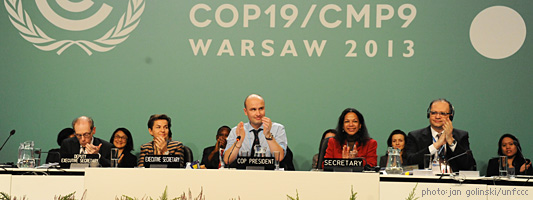

 0 Comment(s)
0 Comment(s) Print
Print E-mail China.org.cn, November 20, 2014
E-mail China.org.cn, November 20, 2014
 |
Below is an overview of key outcomes that governments agreed in Warsaw:
Decisions towards a universal agreement in December 2015, which will enter into force in 2020
? Governments advanced the timeline for the development of the 2015 agreement. They will elaborate the elements of the new climate agreement as of their first meeting in March 2014, table an initial draft text by December 2014, and submit the formal draft text by May 2015, all with a view to enabling the negotiations to successfully conclude in December 2015.
? Governments decided to either begin or to intensify domestic preparations for their nationally determined contributions towards the agreement so that they are ready well before December 2015 and ideally by the first quarter in 2015. This is an important part of the timeline of the negotiations.
? It was also decided that nationally determined contributions would be put forward in a clear and transparent manner. Developed country governments were urged to provide support to developing countries for this important domestic process.
? Governments agreed to identify the precise information that countries will provide when putting forward their nationally determined contributions by the beginning of the UN Climate Change Conference in Lima at the end of 2014.
Closing the pre-2020 ambition gap
? Governments resolved to strengthen measures to close the "ambition gap" – the gap between what has been pledged to date and what is required to keep the world below a maximum average 2 degrees Celsius temperature rise - before the new agreement enters into force in 2020.
? They will intensify the technical examination of opportunities that hold a high potential to curb greenhouse gas emissions and will frequently engage Ministers on the issue.
? To this end, governments will also accelerate the implementation of policies and environmentally sound technologies.
? Additionally, they urge the voluntary cancellation of Certified Emission Reductions (CERs) under the Kyoto Protocol's Clean Development Mechanism.
The urgency to support peoples affected by climate change impacts
? Governments established the Warsaw International Mechanism for Loss and Damage. The mechanism will address losses and damages associated with long-term climate change impacts in developing countries that are especially vulnerable to such impacts.
? The interim implementation of the mechanism will be guided by an executive committee, which will report to the COP, and be reviewed in 2016.
? The mechanism will facilitate the exchange of information and best practices for dealing with climate change-induced losses and damages, as well as strengthen action and support, including by facilitating the mobilization of finance.
? The first meeting of the executive committee will be held in March 2014.
Strengthening efforts to mobilize USD 100 billion by 2020
? In view of developed countries' commitment to mobilize USD 100 billion annually by 2020 to support developing countries in their climate change actions, developed countries agreed to make their efforts in this regard publicly known on a biennial basis from 2014 to 2020. Technical workshops on best ways of scaling up finance will also be held.
? It was also decided to convene Ministerial meetings on long-term finance every two years for the period 2014-2020. These meetings should provide political impetus to the discussions.
? Additionally, the Green Climate Fund is open for business and will begin its initial resource mobilization process in the middle of 2014.
? These sets of decisions represent important progress towards successfully concluding a universal deal in 2015 that responds to science and protects the most vulnerable. In addition, governments concluded work which pushes forward ongoing efforts to address climate change.
Cutting emissions from deforestation – "the Warsaw Framework for REDD+"
? Governments agreed on a set of decisions on ways to reduce emissions from deforestation and forest degradation. The decisions are the culmination of 7 years of work, and their agreement comes as a clear breakthrough for action on climate change.
? Global deforestation accounts for some 20 percent of the world's CO2 emissions. The set of decisions bolsters forest preservation and sustainable use of forests with direct benefits for people who live in and around forests.
? The package provides a foundation for the transparency and integrity of actions and clarifies the coordination of support.
? It establishes the means for results-based payments if developing countries can demonstrate the protection of forests. For this purpose, the package is backed by initial pledges of USD 280 million.
Progress on driving adaptation
? All 48 Least Developed Countries under the UNFCCC umbrella finalized a comprehensive set of plans to deal with climate change impacts. These plans serve to better assess the immediate impacts of climate change and enable countries to determine the support and actions they require to become more resilient.
? Developed countries met the target capitalization of USD 100 million for the Adaptation Fund, which can now continue funding priority projects.
Progress towards accountability
? The framework for measuring, reporting and verifying mitigation efforts, including by developing countries, is now fully operational. A big achievement after many years of hard work, this agreement by governments is important because it means that the mitigation, sustainability and support efforts of countries can now be better measured.
? This will also provide confidence to donors and investors who are potentially interested in financing nationally appropriate mitigation actions.
Technology to boost action on climate change
? The Climate Technology Centre and Network (CTCN), tasked with stimulating technology cooperation and transfer to developing countries, is now open for business.
? The Advisory Board of the CTCN agreed on the rules for the CTCN. This means that the CTCN, established in Cancun in 2010, has now moved to the operational stage to support action by developing countries in response to their requests for support through their national designated entities.
? The CTCN is ready to respond to requests from developing countries on issues related to the development and transfer of technology.